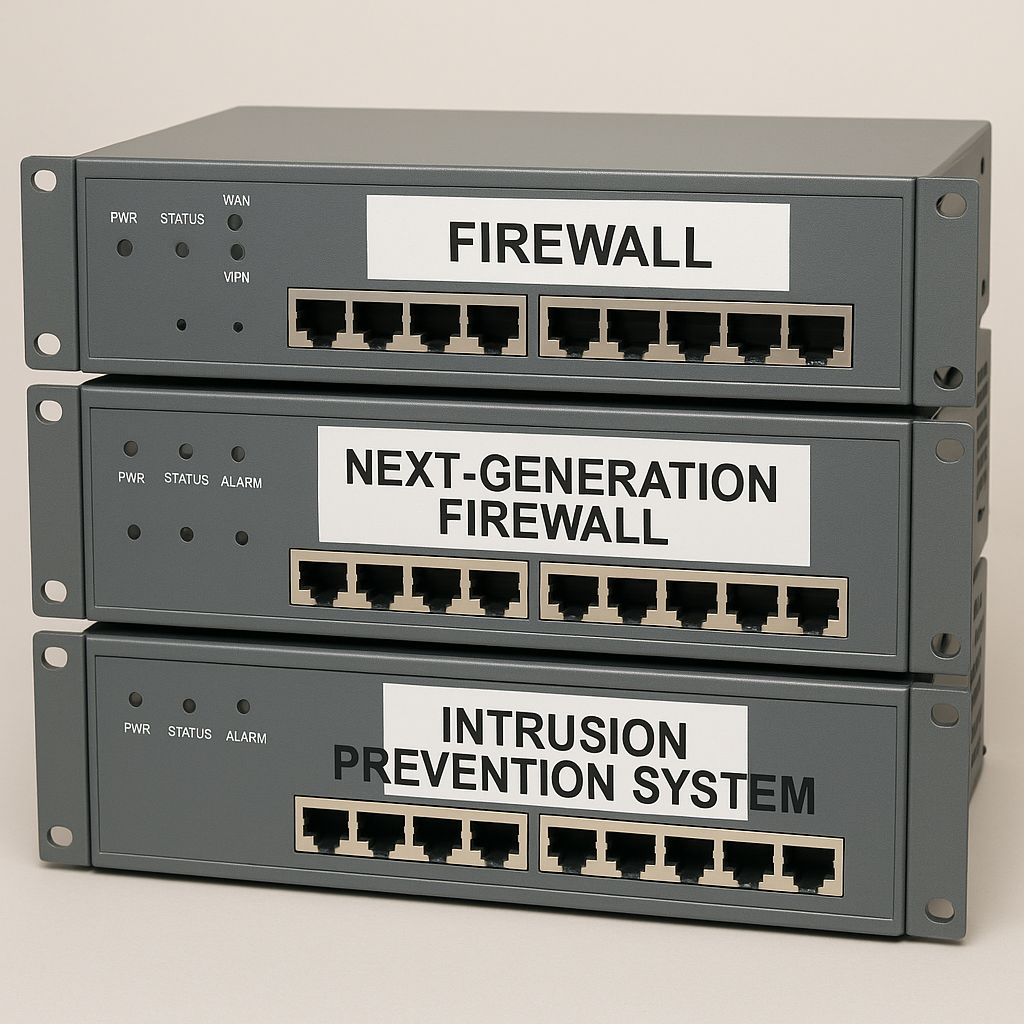📘 CCNA 200-301 v1.1
1.1.c Next-generation firewalls and IPS
1. What is a Firewall? (Quick recap)
- A firewall is a network security device that controls traffic between trusted (inside) and untrusted (outside) networks.
- Traditional firewalls (pre-NGFW) mainly filtered traffic based on:
- Source IP
- Destination IP
- Port numbers
- Protocols (TCP, UDP, ICMP, etc.)
⚠️ Limitation: Traditional firewalls couldn’t inspect what’s inside the packet. They only worked at Layer 3 (Network) and Layer 4 (Transport) of the OSI model.
2. Next-Generation Firewall (NGFW)
An NGFW is an advanced firewall that can do everything a traditional firewall does PLUS much more.
Key Features of NGFW:
✅ Deep Packet Inspection (DPI): Looks inside packets, not just headers.
✅ Application Awareness: Can identify applications (e.g., Facebook, YouTube, Dropbox) even if they use the same port (e.g., port 443 HTTPS).
✅ User Identity Awareness: Integrates with Active Directory / LDAP to enforce rules based on users and groups, not just IP addresses.
✅ Intrusion Prevention System (IPS) Integration: Can detect and block attacks (SQL injection, DoS, worms, etc.).
✅ SSL/TLS Inspection: Can inspect encrypted HTTPS traffic.
✅ Advanced Threat Protection (ATP): Blocks malware and integrates with threat intelligence feeds.
✅ URL Filtering & Content Control: Can block websites by category (e.g., gambling, adult content).
NGFW Placement
- Typically sits at the perimeter of the network (between LAN and Internet).
- Can also be used in data centers for east-west traffic inspection.
💡 Think of NGFW as a firewall + IDS/IPS + Application Control + Threat Intelligence in one box.
3. Intrusion Prevention System (IPS)
An IPS is a network security tool designed to detect and block malicious traffic.
- IDS (Intrusion Detection System): Only detects suspicious activity, alerts admins, but does not block.
- IPS (Intrusion Prevention System): Detects and blocks malicious traffic in real time.
How IPS works:
- Traffic Monitoring – Analyzes packets as they pass through.
- Signature-based Detection – Uses known attack patterns (like antivirus).
- Anomaly-based Detection – Detects unusual behavior (e.g., sudden traffic spikes).
- Action – Drops packets, resets connections, or alerts the admin.
Examples of Attacks an IPS Can Stop:
- DoS / DDoS attacks
- Buffer overflows
- Malware communication
- SQL injection / XSS (cross-site scripting)
- Exploits of unpatched systems
4. NGFW vs IPS – How They Work Together
- An NGFW often includes an IPS as one of its features.
- If a network only has an IPS (without NGFW), it can’t control normal traffic flow like a firewall does.
- If a network only has an NGFW (without IPS), it might miss zero-day attacks unless it has integrated IPS features.
👉 Best practice: Modern enterprises use NGFW with built-in IPS (sometimes called NGIPS).
5. Exam-Level Key Points (What to Remember for CCNA)
🔑 Firewall Basics: Controls access between networks using rules (ACLs).
🔑 Traditional Firewalls: Operate at Layer 3 & 4 (IP addresses, ports).
🔑 NGFW: Adds Layer 7 (application layer) inspection, user-based policies, threat intelligence, and integrated IPS.
🔑 IPS: Monitors traffic in real-time, detects, and blocks malicious activities.
🔑 IDS vs IPS: IDS = Detect only, IPS = Detect + Block.
🔑 Placement: NGFW usually at network edge, IPS inline with traffic.
6. Real-World Example (Simple for Students)
Imagine you’re at a school:
- A traditional firewall can block students from accessing port 21 (FTP) or from using a banned IP address.
- A next-generation firewall (NGFW) can block Facebook even though it uses HTTPS (port 443) – because it recognizes the application.
- An IPS will detect and block a student who tries to launch a DoS attack on the school’s Wi-Fi or run malware on the network.

Explained in plain, real-world IT terms for CCNA:
What a normal firewall does (old style)
- Think of a firewall like a security guard at the building door.
- The guard checks who you are (IP address) and what you want to do (port/service) before letting you in.
- Example:
- “Only staff (10.10.0.0/24 network) can go to the admin server.”
- “Block anyone from using FTP (port 21).”
👉 The old firewalls only check basic info: IP addresses, ports, and protocols.
What a Next-Generation Firewall (NGFW) does
Today, attackers hide inside normal-looking traffic. For example:
- A student uses HTTPS (port 443) to visit Facebook during class. To the old firewall, this just looks like “web browsing” because it’s all on port 443.
- Malware can also use HTTPS to talk to its hacker.
A Next-Generation Firewall (NGFW) goes deeper. It can:
- See inside the traffic (not just the port).
- Recognize applications like YouTube, Facebook, or Dropbox even when they all use HTTPS.
- Block malware before it spreads.
- Check who the user is (by username, not just IP).
- Filter websites (block adult sites, gambling, etc.).
- Stop new attacks using cloud threat updates.
👉 Real IT example:
In a school, you might allow Office 365 traffic but block YouTube during lessons. Both use port 443, but NGFW can tell them apart.
What an IPS (Intrusion Prevention System) does
Even with a firewall, bad traffic can sneak in. That’s where IPS comes in.
IPS = attack detector + blocker.
- It looks at the traffic in detail.
- If it matches a known attack pattern (like SQL injection, worm, or DDoS), it blocks it instantly.
- It can also notice “weird” behavior, like a laptop suddenly flooding the network.
👉 Real IT example:
- If a teacher’s laptop gets infected with ransomware, the IPS will see the unusual behavior and block it before it spreads to file servers.
IDS vs IPS (easy check)
- IDS (Intrusion Detection System): Just reports “I see something bad!” (like a CCTV camera with no guard).
- IPS (Intrusion Prevention System): Reports AND blocks the attack (like a guard who stops the intruder).
How NGFW and IPS fit together
- A firewall = traffic rules (who can go where).
- NGFW = firewall + application control + malware filtering + user awareness.
- IPS = adds deep protection against attacks.
- Modern firewalls (Cisco Firepower, Palo Alto, Fortinet) already include IPS.
For the CCNA exam – Key points to remember
- Traditional firewall = Layer 3 & 4 (IP, ports).
- NGFW = adds Layer 7 (applications, users, deep inspection).
- IPS = blocks attacks in real time.
- IDS = only detects, doesn’t block.
- NGFW + IPS are usually at the network edge (where your LAN meets the internet).
✅ So in real IT:
- Old firewall = only blocks by addresses/ports.
- NGFW = smarter, can block YouTube but allow Office 365, can block malware.
- IPS = acts like an attack bodyguard, blocking hackers and viruses in real time.
Firewall vs NGFW vs IDS vs IPS
(Plain IT explanation)
1. IDS (Intrusion Detection System)
- What it does: Monitors traffic and looks for suspicious activity.
- How it works:
- Uses signatures (known attack patterns) or anomaly detection.
- Sends alerts to administrators when it detects something bad.
- Important: It does not block traffic — it only warns.
- Where it sits:
- Usually connected via a SPAN/mirror port on a switch.
- That means it sees a copy of the traffic but doesn’t sit inline.
👉 Real example: Like a CCTV camera that watches the corridor but can’t physically stop a fight — it just reports it.
2. IPS (Intrusion Prevention System)
- What it does: Same detection as IDS, but it can also block the attack.
- How it works:
- Sits inline with the traffic.
- If it sees an attack, it drops the packet immediately.
- Where it sits:
- Between the switch and the firewall/router (inline).
👉 Real example: Like a security guard watching the CCTV — and immediately stepping in to stop the fight.
3. Firewall (basic)
- Controls traffic using IP addresses and ports.
- Works mainly at Layer 3 and Layer 4.
👉 Example: “Block all FTP traffic (port 21).”
4. NGFW (Next-Generation Firewall)
- A smarter firewall that combines:
- Normal firewall features (IP/port rules).
- Application control (block Facebook, allow Office 365).
- Malware filtering.
- User identity awareness.
- Built-in IPS functionality.
👉 Example: “Allow staff to use Office 365 but block students from using YouTube, even though both use HTTPS (port 443).”
✅ CCNA Key takeaway:
- IDS: Detects only, no blocking (out-of-band).
- IPS: Detects and blocks (inline).
- Firewall: Rules based on IP/ports.
- NGFW: Firewall + application awareness + IPS + threat protection.
IDS, IPS, and firewalls all look very similar as physical devices.
- They’re all usually rack-mounted appliances or small desktop boxes.
- They all have:
- Ethernet ports (for connecting to the network).
- LED lights (status/activity).
- Sometimes management ports (console/USB).
The difference is in how they are connected and what they do:
- IDS (Intrusion Detection System):
- Usually connected to a SPAN/mirror port on a switch.
- It just receives a copy of traffic for monitoring.
- Looks like a firewall box, but it doesn’t block traffic.
- IPS (Intrusion Prevention System):
- Placed inline between network segments (e.g., between LAN and firewall).
- Can actually block packets.
- Firewall / NGFW:
- Controls which traffic is allowed in or out.
- NGFW also inspects applications and includes IPS features.
@learntechfromzero CCNA 200-301, Full course, 1.1.c Next-generation firewalls and IPS #firewall #ngfw #ips #education #cybersecurity ♬ soulless (Slowed) – rivoices

